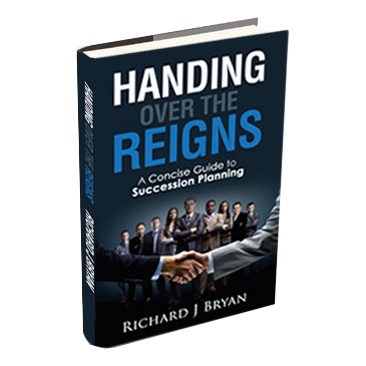What it is, How to Start & How to Succeed
As a consultant and succession planning keynote speaker, I often take it for granted that business owners know what it is, and why it is important. However, several recent virtual conversations with groups of business owners made me realize that this is not the case—so I thought this might be a good time to revisit some succession planning fundamentals.
What is Succession Planning—and Why Does it Matter?
Simply stated, succession planning is a process for planning the orderly transition of business leadership from one generation to the next. This includes identifying and developing new talent to replace incumbent leaders when they leave the organization, retire or pass away. There are countless studies supporting the importance of proactive succession planning, including some alarming statistics:
- 86% of corporate leaders believe succession planning is important
- Only 35% of organizations have a formalized succession planning process
- 14% believe their company does an acceptable job of
- 40% of companies report not having one internal candidate to replace their CEO
- 60% of new executives fail within their first 18 months after promotion or hire
- The direct cost of replacing a failed executive is approximately 10x their salary
The last figure really drives it home, doesn’t it? Even a conservative estimate puts that figure in the millions. Few organizations, especially family-owned businesses, will survive that kind of expenditure—and only the rarest of cool-headed leaders could possibly succeed under that kind of emotional and financial pressure. So, why is succession planning so hard to start?
Why So Many Companies Avoid Succession Planning
The short answer is this: it’s actually NOT difficult to begin taking steps to prepare your family-owned business for a leadership transition, just as it’s not technically difficult to prepare one’s last will and testament. What it is, though is uncomfortable—and this emotional discomfort is often a significant barrier to the succession planning process. Here are three other common reasons people might put things off:
They fear conflict. Many privately owned companies avoid succession planning altogether, fearing it will be a painful process with hard conversations that result in hurt feelings among leaders—some of whom might be family members. They may not be wrong about the difficult conversations; this is a necessary part of the process! But it’s important to remember that a bit of strategic disagreement now is likely to help you avoid bigger conflicts (and consequences) later on.
They think they’re already done. Other organizations consider a succession plan completed when they’ve identified their next CEO, or the person who could potentially assume the position several years down the line. In reality, choosing a successor is just the first step.
They know it’s the end. For some privately held and family owned businesses, succession planning may lead to a decision to sell—and understandably, this can feel like a death in the family! Whether a company fails to identify a candidate to take the business forward or they receive an offer they can’t refuse, it may become clear that exit is the best course of action.
While this can be very hard information to hear, a timely farewell can also have a happy ending! By selling our family car dealership business in 2008, I was not only able to harvest the value we had accumulated through generations of hard work for the benefit of the family shareholders — I was also able to divert my focus to our commercial real estate business, which I was more interested in and is now thriving.
Why Companies (Finally!) Start the Succession Planning Process
The problem with succession planning isn’t that business owners don’t recognize its importance—by and large, they do. Most companies simply fail to recognize its urgency, and continue to put it off until it’s too late. In the case of our family-owned business, it took my father going into hospital for life-threatening surgery to even start the conversation!
Beyond sudden illness and other catastrophes, common late-breaking catalysts might include advice from one’s board or other trusted advisors, recommendations from HR leaders and oversight (or outright pressure) from industry regulators to mitigate long-term risk. While all of these are excellent reasons to get started on your company’s succession plan, my advice is to not wait for any outside forces to light the fires of change.
Making a Strong Start: A Simple 8-Step Succession Plan
Every organization has a unique culture and situation, which requires a customized succession plan. Here are a few basic things to consider when starting on yours:
- Start with the end in mind. Having a good idea of what you want to happen to your business is a good starting point. What is your ideal outcome in the next 5–10 years? Do you want to pass the business on to your children, or another family member? Do you want to sell to your management team—or do you want to sell to an industry player or strategic buyer, for the best price possible?
- Plan your resources. I inherited a business with an aging management team and failing finances, so I knew there was work to be done before I could even think about selling the business! Our resource planning included not only the human resources of new managers, but also the time required to work with our existing car franchises to grow revenue, and further leverage profit by acquiring new franchises.
- Assess and mitigate risk. Some things—catastrophic fires and global pandemics, to name two in recent memory—are impossible to see coming. But it’s critical to take steps to reduce risks for your business by securing products such as “key person” insurance coverage.
- Attain alignment. Are your company’s leaders, stakeholders and board all in agreement on the direction of the business? Top-down alignment is essential for a smooth transition to the next generation. Without a clear succession plan, the transition will be rife with conflict and destructive disorganization—which will put your succeeding leader in an untenable position. This is precisely what happened to me, when I was suddenly forced to fill my father’s CEO shoes at the age of 28!
- Secure commitment. As our main business partners were car manufacturers with franchise agreements, it was important that they be committed to our course of action. Like most automobile companies, their criteria for success included attractive dealership locations with good facility condition; strong management; financial strength; proven customer satisfaction and robust track record of sales performance.
- Always be flexible. On the succession planning keynote speaker circuit, I advise my clients to allow at least 3–5 years for their succession plan to unfold and evolve. This allows the chosen successor to gain experience and knowledge, as the outgoing leader gradually reduces their responsibilities. I would have loved a gradual handover, with mentorship and knowledge transfer from my father! It would have been far less stressful than the sink-or-swim situation I found myself in.
- Seek advice. A little money spent now on a team of trusted advisors will save you a lot of time and money in the future. You may need help from a CPA, lawyer or financial advisor—or all three, depending on the size and complexity of your business. It’s also wise to secure a succession planning consultant to help guide you through this process, and make sure you have a plan that can be successfully implemented.
- Finally—JUST START! Remember: the best succession plans are not necessarily the most complex. Take that critical first step by putting your plan in writing, taking all the previous steps to heart and knowing that you have several years to revise and refine. When it comes to succession planning, the best time to start is always NOW.
In summary: do the basics, and you will be ahead of the pack! Even if retirement seems like a distant dream and there are more pressing things that demand your attention, it’s time to start. Secure your life’s work and legacy by passing on your business in a controlled way, rather than rushing to put a plan together in a crisis. Take it from someone who knows.
Related Topics:
Business Contingency Planning: What, Why + How
Stepping Out, Not Down: Why Your Aging CEO Won’t Retire
The Role of the Board During Family Business Succession


